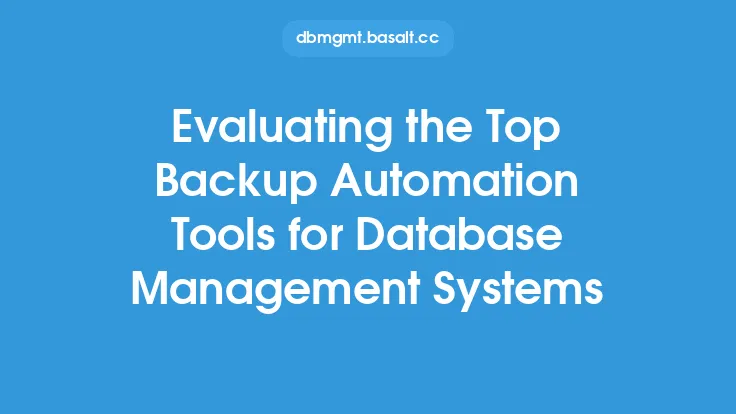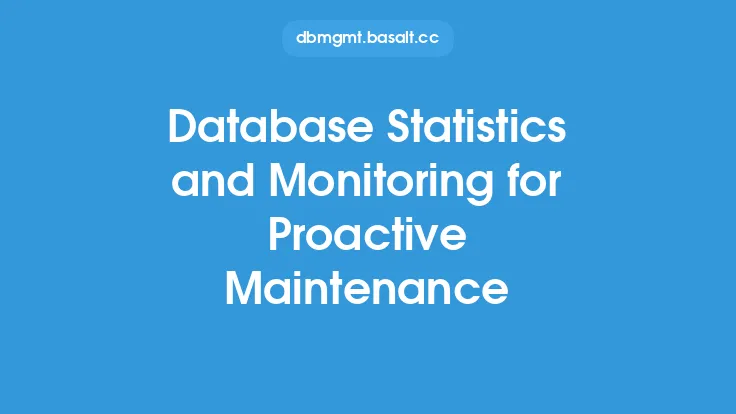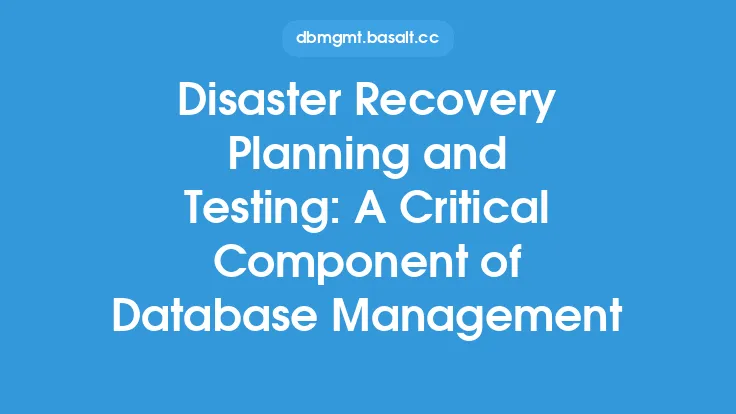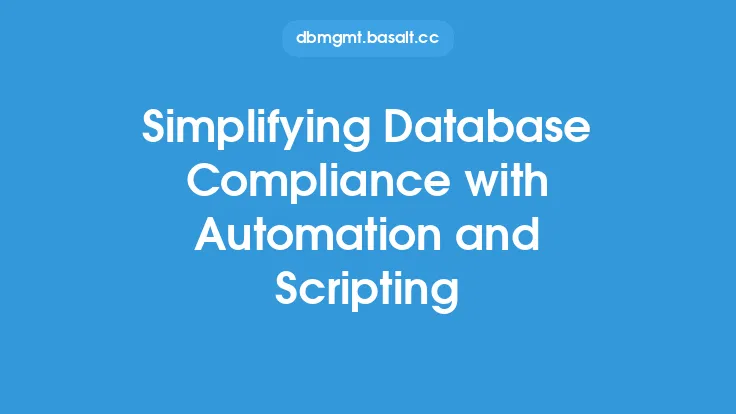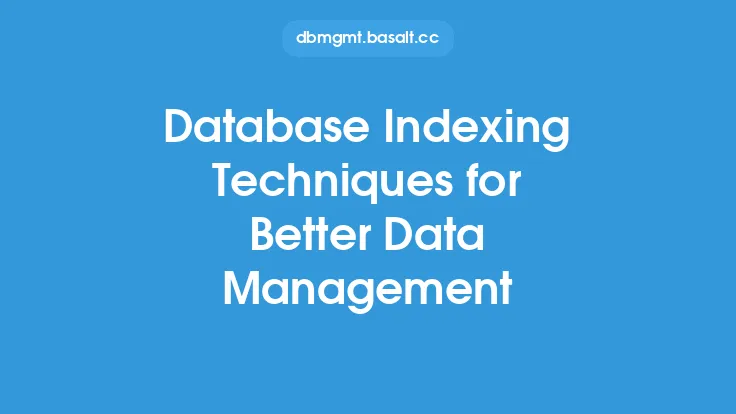Database automation is a crucial aspect of maintaining and managing databases, as it enables organizations to streamline their database maintenance and management processes, reduce manual errors, and improve overall efficiency. By automating repetitive and time-consuming tasks, database administrators can focus on more strategic and high-value tasks, such as optimizing database performance, ensuring data integrity, and improving data security.
Introduction to Database Automation
Database automation involves the use of software tools and scripts to automate various database management tasks, such as backups, updates, and maintenance. This can include tasks such as data replication, indexing, and statistics gathering, as well as more complex tasks such as database provisioning, patching, and upgrading. By automating these tasks, organizations can reduce the risk of human error, improve consistency, and increase productivity.
Benefits of Database Automation
The benefits of database automation are numerous and well-documented. Some of the most significant advantages include:
- Improved efficiency: Automation enables organizations to automate repetitive and time-consuming tasks, freeing up database administrators to focus on more strategic and high-value tasks.
- Reduced risk: Automation reduces the risk of human error, which can lead to data loss, corruption, or other issues.
- Increased consistency: Automation ensures that tasks are performed consistently, which can improve data quality and reduce errors.
- Enhanced scalability: Automation enables organizations to scale their database operations more easily, as automated tasks can be easily replicated and distributed across multiple databases.
- Better compliance: Automation can help organizations comply with regulatory requirements and industry standards, such as data retention and backup policies.
Database Automation Tools and Technologies
There are a variety of database automation tools and technologies available, each with its own strengths and weaknesses. Some of the most popular tools include:
- Database management system (DBMS) built-in automation tools, such as Oracle's Enterprise Manager and Microsoft's SQL Server Management Studio.
- Third-party automation tools, such as Redgate's SQL Automation and Apex's Data Loader.
- Open-source automation tools, such as Ansible and Puppet.
- Cloud-based automation tools, such as Amazon's Database Migration Service and Google's Cloud Dataflow.
Automating Database Maintenance Tasks
Database maintenance tasks, such as backups, updates, and maintenance, are critical to ensuring the health and performance of databases. Automation can help streamline these tasks, reducing the risk of human error and improving consistency. Some examples of database maintenance tasks that can be automated include:
- Backup and recovery: Automating backup and recovery processes can ensure that data is properly backed up and can be quickly recovered in the event of a failure.
- Patching and updating: Automating patching and updating processes can ensure that databases are up-to-date with the latest security patches and features.
- Indexing and statistics gathering: Automating indexing and statistics gathering can improve query performance and reduce the risk of data errors.
- Data replication: Automating data replication can ensure that data is properly replicated across multiple databases, improving data availability and reducing the risk of data loss.
Automating Database Provisioning and Deployment
Database provisioning and deployment are critical tasks that can be time-consuming and error-prone. Automation can help streamline these tasks, reducing the risk of human error and improving consistency. Some examples of database provisioning and deployment tasks that can be automated include:
- Database creation: Automating database creation can ensure that databases are properly configured and provisioned, reducing the risk of errors and improving consistency.
- Schema deployment: Automating schema deployment can ensure that database schemas are properly deployed and updated, reducing the risk of errors and improving consistency.
- Data loading: Automating data loading can ensure that data is properly loaded into databases, reducing the risk of errors and improving consistency.
Best Practices for Implementing Database Automation
Implementing database automation requires careful planning and execution. Some best practices for implementing database automation include:
- Start small: Begin with a small pilot project to test and refine automation processes before scaling up to larger databases.
- Choose the right tools: Select automation tools that are well-suited to the organization's specific needs and requirements.
- Develop a comprehensive automation strategy: Develop a comprehensive automation strategy that takes into account the organization's specific needs and requirements.
- Monitor and refine automation processes: Continuously monitor and refine automation processes to ensure they are working effectively and efficiently.
- Provide training and support: Provide training and support to database administrators and other stakeholders to ensure they are comfortable using automation tools and processes.
Common Challenges and Limitations of Database Automation
While database automation offers many benefits, there are also some common challenges and limitations to be aware of. Some of the most significant challenges and limitations include:
- Complexity: Database automation can be complex and require significant expertise and resources to implement and maintain.
- Cost: Database automation tools and technologies can be expensive, especially for large and complex databases.
- Security: Database automation can introduce new security risks, such as the risk of automated tasks being compromised or exploited by malicious actors.
- Dependence on automation: Over-reliance on automation can lead to a lack of understanding and expertise among database administrators, making it more difficult to troubleshoot and resolve issues.
Future of Database Automation
The future of database automation is likely to be shaped by emerging trends and technologies, such as artificial intelligence, machine learning, and cloud computing. Some potential future developments in database automation include:
- Increased use of artificial intelligence and machine learning: AI and ML can be used to improve automation processes, such as predictive analytics and automated troubleshooting.
- Greater adoption of cloud-based automation tools: Cloud-based automation tools can provide greater flexibility, scalability, and cost-effectiveness than traditional on-premises tools.
- Increased focus on security and compliance: As data breaches and cyber attacks become more common, there will be an increased focus on security and compliance in database automation.
- Greater emphasis on automation of complex tasks: As automation becomes more widespread, there will be a greater emphasis on automating complex tasks, such as data integration and data governance.

